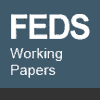
| Finance and Economics Discussion Series |
|---|
 |
Quantitative Monetary Easing and Risk in Financial Asset Markets Takeshi Kimura and David Small 2004-57 |
Abstract: In this paper, we empirically examine the portfolio-rebalancing effects stemming
from the policy of "quantitative monetary easing" recently undertaken by the Bank
of Japan when the nominal short-term interest rate was virtually at zero. Portfolio-rebalancing
effects resulting from the open market purchase of long-term
government bonds under this policy have been statistically significant. Our results
also show that the portfolio-rebalancing effects were beneficial in that they reduced
risk premiums on assets with counter-cyclical returns, such as government and
high-grade corporate bonds. But, they may have generated the adverse effects of
increasing risk premiums on assets with pro-cyclical returns, such as equities and
low-grade corporate bonds. These results are consistent with a CAPM framework
in which business-cycle risk importantly affects risk premiums. Our estimates
capture only some of the effects of quantitative easing and thus do not imply that
the complete set of effects were adverse on net for Japan's economy. However, our
analysis counsels caution in accepting the view that, ceteris paribus, a massive
large-scale purchase of long-term government bonds by a central bank provides
unambiguously positive net benefits to financial markets at zero short-term interest
rates.
Home | FEDS | List of 2004 FEDS papers
Accessibility
To comment on this site, please fill out our feedback form.
Last update: October 19, 2004